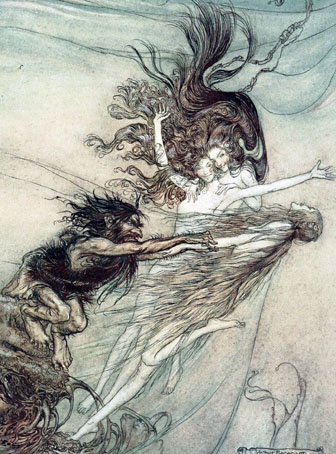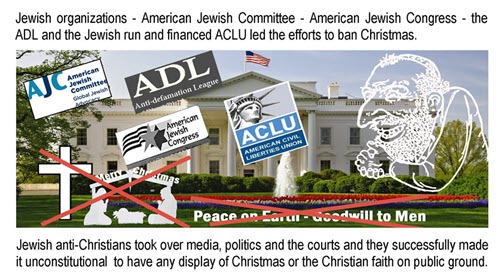 Jewish Supremacists claim to hate Richard Wagner because of some association with Hitler, but the real reason is that the German composer drew an analogy with Jews and Jewish behavior in his famous Ring of the Nibelung opera cycle, famous Argentinian commentator Adrian Salbuchi has said.
Jewish Supremacists claim to hate Richard Wagner because of some association with Hitler, but the real reason is that the German composer drew an analogy with Jews and Jewish behavior in his famous Ring of the Nibelung opera cycle, famous Argentinian commentator Adrian Salbuchi has said.
Speaking on the Dr. David Duke radio show yesterday, Mr Salbuchi provided a brief overview of the clear parallels between the dwarf Alberich in the opera, and Jewish bankers. The fascinating broadcast can be heard at the Rense Radio archives here.
Wagner’s attitude towards Jews is embodied in the opera’s dwarven characters, Alberich and Mime.
It was Wagner’s argument that the Jews, through their prominence in banking institutions and the growing publishing industry, were non-Germans who exerted an unprecedented influence on the modern world in general and on the theatrical and musical institutions of Europe in particular.
He regarded them as endowed with a host of the very ‘non-German’ traits he had associated with post-Hellenic culture in ‘Die Kunst und die Revolution’: avarice, egotism, lovelessness, immorality, a carnal nature, and an ability to mimic (though imperfectly) the society in and from which they lived.
The reoccurring setting of the Rhine in The Ring of the Nibelung is of crucial importance in understanding the Jewish threat to German culture.
The basis of this threat was the infiltration of the Rhine river by Jewish merchants. By the end of the fourteenth century, Jewish centers along the Rhine included Cologne, Mainz, Speyer and Worms, and with continued founding of Jewish settlements the estimated number of Jews ranged from 20,000 to 50,000. (Ruth Gay. The Jews of Germany: A Historical Portrait. London: Yale University Press, 1992: 8-9)
The publisher Otto Wigand, in 1858 referred to the “racial antagonism between the children of Jacob who are of Asiatic descent, and the descendents of Teut and Hermann who have inhabited Europe from time immemorial, between the proud and tall, blond Aryan and the short, black-eyed, dark-haired Jew,” and he went on: “Races which differ to such degree, oppose each other instinctively and, against such opposition, reason and good sense are powerless.”
Thus, clearly are defined the physical templates which Wagner uses to divide and classify the Volsungs from the Nibelungs, and the Rhine symbolizes a battlefield of Germanic soil, upon which Jewish culture had invaded.
In Wagner’s booklet, Judaism in Music (Das Judenthum in der Musik), first published in 1850 under a pseudonym in the Neue Zeitschrift für Musik, he wrote that Jewish music is bereft of all expression, characterized by coldness and indifference, triviality and nonsense.
The Jew, he claimed, has no true passion to impel him to artistic creation. The Jewish composer, according to Wagner, makes a confused heap of the forms and styles of all ages and masters.
In Deutsche Kunst und Deutsche Politik, Wagner spoke of the “harmful influence of Jewry on the morality of the nation,” adding that the subversive power of Jewry stands in contrast to the German psyche.
On its most prevalent level, the Ring of the Nibelung is about the struggle of power in opposition to love. Power is signified by the gold protected by the Rhinemaidens, which can only be obtained by the renunciation of love; “He must pronounce a curse on love,” and “must renounce all joys of love” (Rhinegold, Scene I).
The currency of power is understood to be gold, which may be accumulated by the intrinsic power of a ring fashioned from the initially claimed gold of the Rhinemaidens.
A speculative assessment concludes that the Rhinemaidens gold is in no way different from the gold the Alberich commands his enslaved race to collect, but rather the items fashioned from the gold originally stolen from the Maidens possesses its power by the conscious choice of its procurer to renounce love.
Thus, greed is not ephemeral but rather engenders its own perpetuation through the initial choice. Wagner’s decision to utilize this medium no doubt relates to the importance of wealth to the culture of European Jews. The implication that arises is that Love is in direct opposition to power and greed, and that by choosing the latter over the first is to define Jewish moral beliefs.
As presented, and in affiliation with common perceptions of Jewry, this is a choice that can only be made by a person of Jewish lineage. It identifies Alberich as cold and greedy, incapable of love beyond that for possession and power.
Moreover, the gold must be stolen. The maidens identify Alberich as a “robber” who must “seize from the rock [their] gold,” (Rhinegold, Scene I) and by so doing, distance him from moral consciousness. Furthermore, Alberich’s plans for the gold are equally devoid of morality, exemplifying ignorant greed and the unrivaled desire to exert power over all things:
Gold can be mined here,
And gold can be stored here,
Deep in Nibelheim’s caves.
Then with my wealth
From the darkness I’ll rise,
Rise and be master of all things;
The whole wide world
I’ll buy for myself with the treasure! (Rhinegold, Scene 3)
This prediction is novel to the gods Loge and Wotan, to whom it is addressed, because they are of a superior race that needs no system of barter. The oaths on Wotan’s spear suffice as contractual. Wagner’s disapproval of Jewish prominence in banking institutions is incorporated into the Nibelung’s inferior stature as a race from which he infers that they must scheme and create a monetary method of gaining power.
My golden grasp
will seize on you gods and destroy you!
Once I renounced all joys of love.
All those who live,
all shall renounce them!
Enchanted by gold
your greed for gold shall enslave you!
For first your men
shall yield to my might,
then your lovely women,
who despise me and jeer,
shall grant to Alberich’s force
what love could not win! (Rhinegold, Scene III)
Jews, as Wagner perceived them, are morally inferior to their German neighbors, as the Nibelheim dwarves are inferior to the races beneath whom they live.
It is not surprising therefore that Loge and Wotan must descend beneath the realm they inhabit to the caves in which this race hovers. In his essay Versuch über Wagner, Theodore W. Adorno puts forward the thesis that Alberich and Mime, at the deepest level are Jewish caricatures, describing Alberich as ‘obsessed with gold, invisibly anonymous and quick to exploit others,’ while Mime is described as ‘shoulder-shrugging, garrulous and bubbling over with deceit.’
Mime is equally cunning, and indulges the same initiative of furthering his own gain to the extent of oppressing all those around him, including his brother. As he reveals to Loge, in forging the tarnhelm his intentions are to “keep one thing for [himself] and use the spell to free [him] from Alberich’s power…by using the helm [he] might catch him. That ring – could [he] but seize it, then though [he’s] forced now to serve him, when free, [he] could make [Alberich] [his] slave.” (The Rhinegold, Scene III)
Wagner depicts that the need for power is self-consuming, and in a race naturally devoid of virtue, power can only be attained by his Jewish caricatures through the false pretense of treachery. Thus, Wagner collaborates the amoral view of greed established in his dwarven characters with the prominence of Jews in European banking.
That the Volsung-as-German hero is the opposite of the Nibelung-as-Jew is suggested in ‘Das Judentum in der Musik’ when Wagner writes that ‘we cannot imagine an antique or modern character, be it a hero or a lover, represented by a Jew on stage, without in the process sensing the inappropriateness – to the point of comedy – of such an idea.’
Siegfried himself repeatedly draws attention to the difference between his physiology and that of his foster parent and in so doing underscores Wagner’s belief in the indelible appearance, in the corporeal encoding, of racial difference.
This belief surfaces most vehemently when Siegfried scorns Mime for claiming to be his parent(s), and the basis for his anger toward and hatred of Mime are founded on the obvious physical differences between the two.
And there in the stream
I saw my face –
It wasn’t like yours,
Not in the least,
No more than a toad
Resembles a fish.
No fish had a toad for a father! (Siegfried, Act I, Scene I)
Though its mythological influence and surface theme of love in opposition to power define The Ring of the Nibelung as a classic and integral story that perpetuates itself in its attempt to define the nature of man, Wagner has intentionally made his opera a political statement of the threat of Jewish infiltration of Germanic soil.
Accordingly, Alberich and Mime, Wagner’s personifications of the Jewish race which he views with animosity, are portrayed as a contemptible force that can only fail in the opposition of German virtue.



